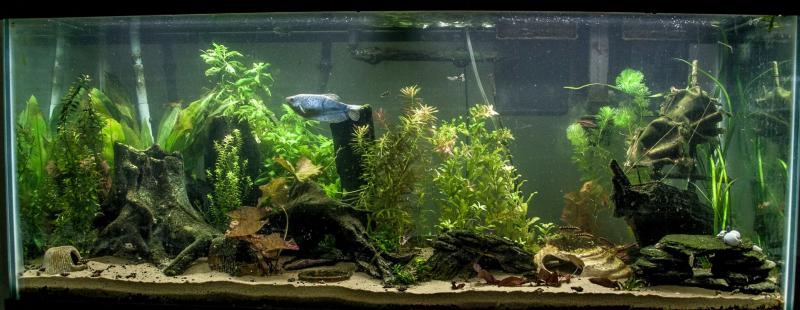Luananeko
Aquarium Advice Addict
I've been having issues with my 75 gallon heavily planted tank and the current theory is a persistent parasite infestation... I've done treatments with Prazipro, but I've been told that I need to thoroughly vacuum the gravel after or the fish can get reinfected when scavenging through the substrate. I have too much substrate to begin with (around 5-6" of gravel, a layer of eco-complete, and topped with a thin gravel layer) and want to swap out the gravel for sand, while keeping the eco-complete layer.
What's the best way to do this? My current plan is...
1) Put fish and plants all into buckets with existing tank water.
2) Drain tank down as low as siphon allows.
3) Carefully scoop out top layer of eco-complete and gravel and save in another bucket of tank water.
4) Scoop out rest of gravel in strainer to allow to dry out and store.
5) Pick out as much gravel as possible from eco-complete bucket and vacuum eco-complete thoroughly, and add back into tank.
6) Top off with dune sand.
7) Fill tank halfway with water.
8) Replant the plants.
9) Sterilize and replace decor.
10) Fill tank rest of the way.
11) Acclimate fish to new tank water then add back to tank.
Are there any steps I'm missing? Is this too drastic of a change for the fish to adjust to? I'm trying to minimize all chances of the parasite making it through the process, but I don't want to kill off my fish in the process...
Any suggestions are appreciated!
Edit: Some additional info... I have both a canister filter and a HOB filter packed with bio media... The tank is understocked atm due to having lost about half my fish over the last few months to this supposed parasite problem. I do 50% water changes weekly and use purigen in my filter as well, so in theory this should be enough filtration to prevent a mini-cycle, right?
What's the best way to do this? My current plan is...
1) Put fish and plants all into buckets with existing tank water.
2) Drain tank down as low as siphon allows.
3) Carefully scoop out top layer of eco-complete and gravel and save in another bucket of tank water.
4) Scoop out rest of gravel in strainer to allow to dry out and store.
5) Pick out as much gravel as possible from eco-complete bucket and vacuum eco-complete thoroughly, and add back into tank.
6) Top off with dune sand.
7) Fill tank halfway with water.
8) Replant the plants.
9) Sterilize and replace decor.
10) Fill tank rest of the way.
11) Acclimate fish to new tank water then add back to tank.
Are there any steps I'm missing? Is this too drastic of a change for the fish to adjust to? I'm trying to minimize all chances of the parasite making it through the process, but I don't want to kill off my fish in the process...
Any suggestions are appreciated!
Edit: Some additional info... I have both a canister filter and a HOB filter packed with bio media... The tank is understocked atm due to having lost about half my fish over the last few months to this supposed parasite problem. I do 50% water changes weekly and use purigen in my filter as well, so in theory this should be enough filtration to prevent a mini-cycle, right?

